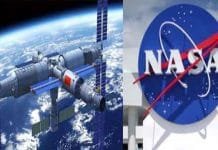INVC NEWS
Washington : Explore the challenges of sending humans to Mars in our comprehensive article. From radiation threats to technological aspirations, dive into the complex world of interplanetary exploration
In the realm of space exploration, recent achievements like Chandrayaan-3 have reignited the world’s fascination with the cosmos and the possibilities that lie beyond our home planet. While endeavors like studying the Moon and the Sun have garnered significant attention, the spotlight has shifted to a more distant destination: Mars. The question that captivates minds and ignites imagination is whether the red planet holds the potential to support human life. This inquiry becomes even more pressing in the face of the growing climate crisis on Earth, which has led scientists and thinkers to ponder alternative habitats for humanity’s survival.
Amid these discussions, the National Aeronautics and Space Administration (NASA) stands as a central figure, often at the forefront of pushing the boundaries of human exploration. Dr. Michel Thaler, a distinguished NASA scientist, brings a realistic perspective to the table. He asserts that, given the current technological landscape, the prospect of sending humans to Mars remains a formidable challenge. On the flip side of this cautious outlook is the ambitious vision put forth by Elon Musk, the visionary founder of SpaceX and a billionaire with grand aspirations. Musk’s optimism shines through his ambitious goal of transporting one million individuals to Mars by the year 2050—an aspiration he has underlined in various recent interviews.
The Ambitious Endeavor and Technological Realities
However, the path to Mars is not paved with mere dreams; it demands cutting-edge technologies, unprecedented innovation, and an unwavering commitment to conquering astronomical challenges. NASA, while acknowledging the allure of a Mars mission, clarifies that the agency’s focus remains on more immediate objectives. The monumental task of reaching Mars is primarily underscored by the sheer distance that must be traversed—an astonishing 34 million miles. This staggering expanse poses a multifaceted challenge, encompassing the safe transportation of the crew to the red planet and their subsequent return to Earth.
Radiation: The Invisible Foe
Yet, the challenges are not limited to the vastness of space; they extend to the perils that lurk within it. NASA’s perseverance in exploring Mars is tempered by the sobering reality of radiation. While the agency’s Mars rovers tirelessly collect data, another ominous truth looms: radiation can be a silent, lethal adversary. The cosmic radiation, solar flares, and coronal mass ejections that characterize interstellar space pose a dire threat to human life. With present-day technology, protecting astronauts from this onslaught of radiation during the journey and upon arrival on Mars remains an arduous task.
Confronting the Hostile Martian Environment
Beyond radiation, the Martian surface presents a harsh and unforgiving environment. Unlike Earth, Mars lacks a robust atmosphere and a magnetic field, rendering it vulnerable to the unrelenting barrage of energetic particles. As humanity contemplates setting foot on Mars, the need for groundbreaking technology to shield astronauts from this double onslaught of radiation becomes paramount. These energetic particles have the potential to shatter the very atoms they collide with, be it the metal walls of spacecraft or the protective barriers of habitats.
A Symbiotic Relationship: Mars and the Moon
In the grand tapestry of space exploration, Mars and the Moon share an intriguing symbiotic relationship. The Moon, as a relatively proximate celestial neighbor, offers a proving ground for new devices, technologies, and life support systems that could be integral to successful Mars missions. It serves as a laboratory for testing habitation techniques, life-sustaining technologies, and novel instruments, laying the groundwork for humanity’s grandest endeavor: establishing a foothold on another planet.
In conclusion, the aspiration of sending humans to Mars, while undeniably captivating, is a monumental challenge that demands the fusion of imagination, innovation, and perseverance. Dr. Michel Thaler’s pragmatism and Elon Musk’s audacity represent two sides of a complex coin—one grounded in current technological limitations, the other propelled by a boundless vision of human potential. As we gaze toward the red planet, we confront not only the staggering distance and the rigors of space travel, but also the invisible threats posed by cosmic radiation. While the Martian surface tantalizingly beckons, its thin atmosphere and lack of a magnetic shield present formidable challenges.
A Glimpse of the Future
The future of space exploration is intricately tied to the advancements we make, the technologies we create, and the innovations we nurture. While a Mars mission remains a formidable endeavor, its challenges have the potential to push human ingenuity to unprecedented heights. As we strive to overcome the obstacles that stand between us and the cosmos, we are writing a new chapter in the history of exploration—one that is defined by audacious dreams and the relentless pursuit of knowledge.














